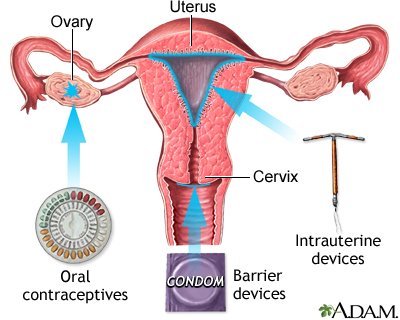
Overview
Artificial contraception methods work in different ways to decrease the likelihood that sexual intercourse will result in pregnancy. Barrier methods such as condoms (male or female), diaphragms (with or without spermicide) and sponges (with spermicide) have as their first line of defense the physical blocking of the sperm's entry into the uterus. If sperm cannot get into the uterus it cannot fertilize an egg, and pregnancy cannot occur. IUDs disrupt the normal uterine environment. The hormones in oral contraceptives and hormone implants fool the ovaries into refraining from ovulation, and without a fertile egg, pregnancy will not occur. IUDs and oral contraceptives and hormones may be used as emergency contraception in the case of unprotected sex, but neither one will protect against sexually-transmitted disease.
Review Date 4/19/2022
Updated by: John D. Jacobson, MD, Department of Obstetrics and Gynecology, Loma Linda University School of Medicine, Loma Linda, CA. Also reviewed by David C. Dugdale, MD, Medical Director, Brenda Conaway, Editorial Director, and the A.D.A.M. Editorial team.


